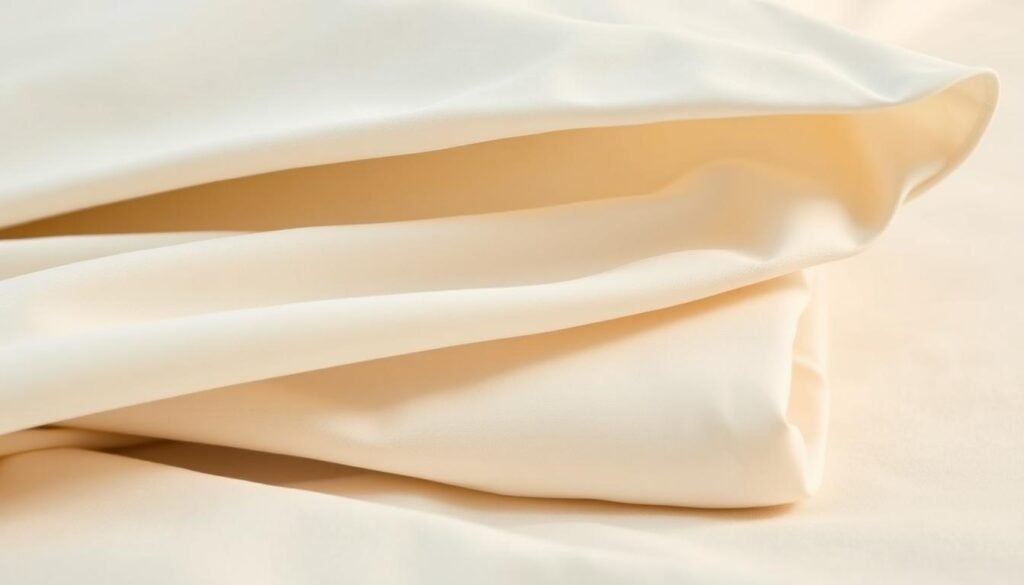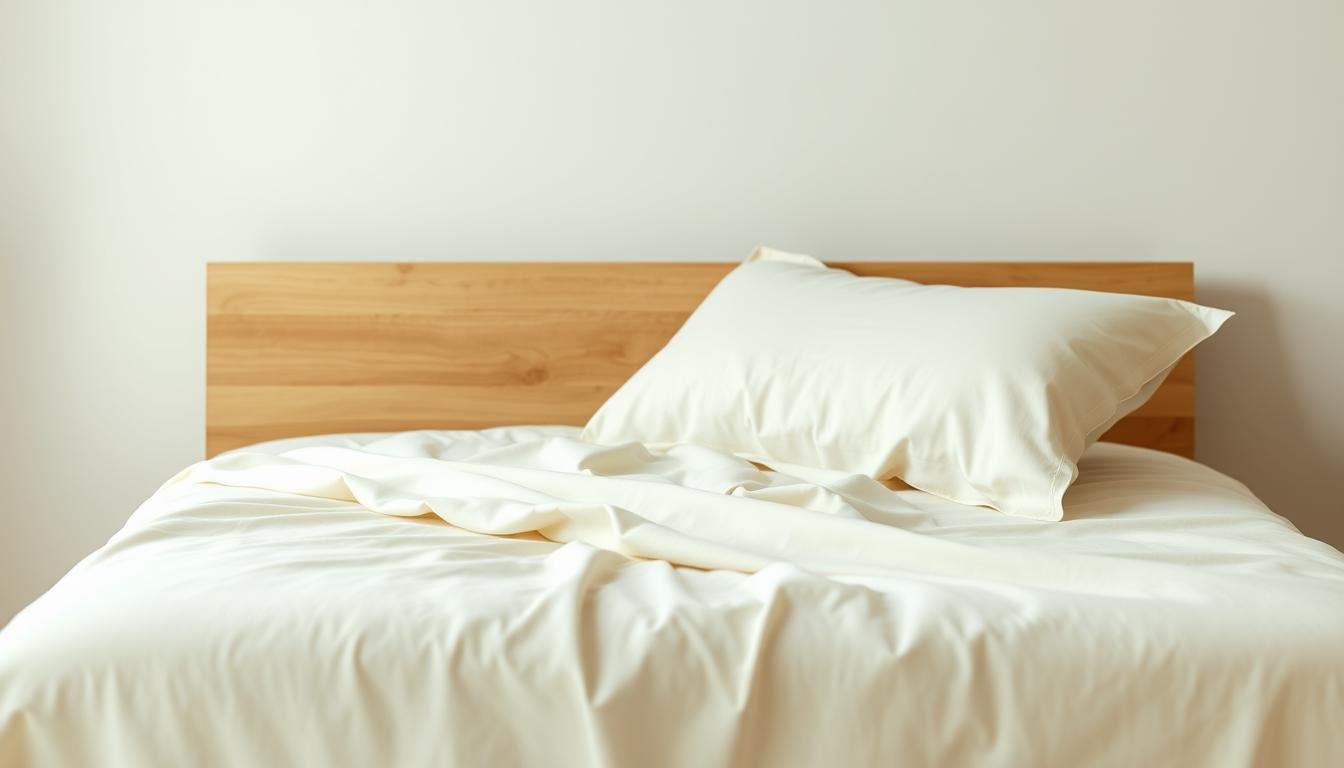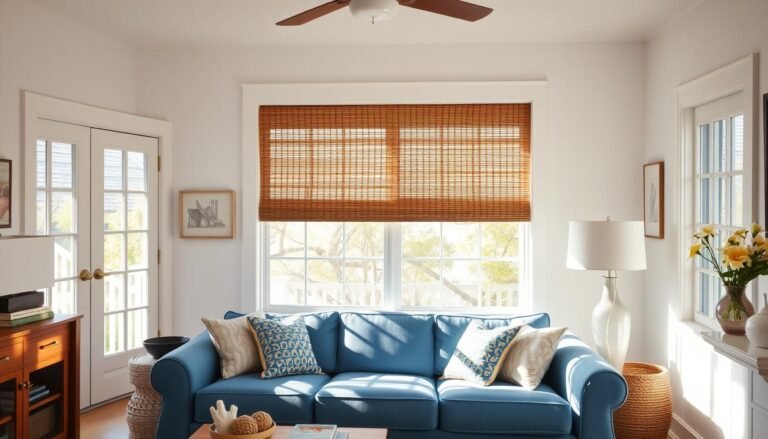Did you know the bedding industry is moving towards more sustainable options? Eco-friendly sheets are becoming more popular.
Pure bamboo sheets are gaining attention for their durability and eco-friendliness. As people care more about the environment, bamboo bedding is in demand.
So, what’s so great about bamboo sheets? They’re soft on skin and keep you cool at night. But, like any product, they have their downsides.
Key Takeaways
- Understanding the composition of bamboo sheets
- Exploring the eco-friendly aspects of bamboo bedding
- Evaluating the durability and price range of bamboo sheets
- Assessing the benefits and drawbacks of switching to bamboo bedding
- Considering the sustainability of bamboo as a resource
What Are Pure Bamboo Sheets?
Bamboo grows fast and doesn’t harm the environment much. It’s used to make very comfy bedding. Pure bamboo sheets come from bamboo fibers. This section will explain bamboo fabric, the types of bamboo sheets, and how they’re made.
Understanding Bamboo Fabric
Bamboo fabric comes from bamboo plants. First, the bamboo is harvested and then turned into soft material. This process breaks down the bamboo into fibers, which are woven into fabric.
This fabric is soft, breathable, and keeps a natural temperature. It’s also good for people with allergies because it’s hypoallergenic. Plus, it’s made in an eco-friendly way.
Types of Bamboo Sheets
There are many types of bamboo sheets. They meet different needs and tastes. Here are a few:
- 100% Bamboo Sheets: These sheets use only bamboo fibers. They’re great for getting all the benefits of bamboo.
- Bamboo Blend Sheets: These mix bamboo with other materials like cotton or polyester. They offer a mix of bamboo’s benefits and other fabrics’ durability.
- Organic Bamboo Sheets: These are made without harmful chemicals or pesticides. They’re perfect for those who care about the environment.
Manufacturing Process
Making pure bamboo sheets involves several steps. From harvesting bamboo to weaving the fabric, here’s what happens:
| Step | Description |
|---|---|
| Harvesting | Bamboo is harvested in a way that doesn’t harm the environment too much. |
| Pulping | The bamboo is turned into pulp, which is then processed into something usable. |
| Fiber Production | The pulp is turned into fibers, which are then spun into yarn. |
| Weaving | The yarn is woven into fabric using a loom, creating the final bamboo fabric. |
Knowing how bamboo sheets are made and the different types helps you choose better. Pure bamboo sheets are comfy, sustainable, and durable. They’re a great choice for upgrading your bedding.
Benefits of Pure Bamboo Sheets
Pure bamboo sheets offer many benefits that make sleeping better and help the planet. We’ll dive into these advantages, showing why bamboo bedding is getting more popular.
Softness and Comfort
Pure bamboo sheets are incredibly soft and comfortable. Bamboo fabric is gentle on your skin, giving a luxurious feel that’s hard to find elsewhere.
The softness comes from bamboo fibers’ natural smoothness. This makes bamboo bedding great for those with sensitive skin or allergies.
Temperature Regulation
Bamboo sheets are known for keeping you cool in summer and warm in winter. They allow for airflow and wick away moisture.
- Breathability: Bamboo fabric lets air flow well, preventing overheating.
- Moisture Wicking: Bamboo sheets pull moisture away from your body, keeping you dry and comfy.
Hypoallergenic Properties
Pure bamboo sheets are hypoallergenic, perfect for allergy sufferers. They resist dust mites, mold, and mildew, lowering allergy risks.
These properties are great for people with sensitive skin or breathing problems. They offer a healthier sleep space.
Eco-Friendly Nature
Bamboo is an eco-friendly crop that needs little water and pesticides. Choosing pure bamboo sheets supports green practices.
Bamboo’s eco-friendliness goes beyond growing. It’s biodegradable, reducing environmental harm at the end of its life.
| Benefits | Description | Advantage |
|---|---|---|
| Softness and Comfort | Gentle on the skin, luxurious feel | Enhanced sleeping comfort |
| Temperature Regulation | Breathable, moisture-wicking | Regulated body temperature |
| Hypoallergenic Properties | Resistant to dust mites, mold, and mildew | Healthier sleeping environment |
| Eco-Friendly Nature | Sustainable, biodegradable | Reduced environmental impact |
How Pure Bamboo Sheets Compare to Cotton
When looking for the best sleep, knowing the difference between bamboo and cotton sheets is key. We’ll look at the main differences to help you decide.
Softness Level Comparison
Pure bamboo sheets are known for their softness, similar to top-quality cotton. Bamboo’s unique fiber makes it smooth and round, which is gentle on your skin. This makes it a great choice for a cozy bed.
Cotton is soft too, but it can feel a bit rougher. This is more common with regular cotton, not Egyptian or long-staple cotton. Bamboo stays soft even after many washes, making it a long-lasting bedding option.
Durability and Longevity
When picking bedding, durability is important. Bamboo sheets are tough and can handle lots of washing and use without losing their quality.
| Characteristics | Pure Bamboo Sheets | Cotton Sheets |
|---|---|---|
| Softness Retention | High | Moderate |
| Durability | High | Moderate to High |
| Maintenance | Easy | Easy |
Maintenance and Care
Both bamboo and cotton sheets are easy to take care of, but there are some differences. Bamboo sheets can usually be machine washed and dried, but it’s best to use a cooler wash to keep them in good shape.
- Bamboo Sheets: Machine wash cold, tumble dry low, or line dry.
- Cotton Sheets: Machine wash warm, tumble dry medium to high.
Knowing these differences helps you pick the right bedding for you. This ensures a comfortable and peaceful sleep.
Choosing the Right Pure Bamboo Sheets
Choosing pure bamboo sheets can seem hard, but knowing what to look for makes it easier. It’s important to think about a few key things. These things affect how good and comfy your bamboo bedding will be.
Thread Count Considerations
Thread count is often thought to show quality, but it’s not always the most important thing for bamboo sheets. Bamboo is soft and strong, no matter the thread count. But, a higher count might mean a softer sheet.
A thread count of 300 to 500 is usually a good mix of softness and strength for bamboo sheets. Remember, the type of bamboo and how it’s made also matter a lot for quality.
Weave Types Explained
The weave of your bamboo sheets can really change how they feel and work. Here are the main weave types:
- Twill Weave: It’s soft and smooth, and also very durable.
- Sateen Weave: It’s luxurious and soft, with a bit of shine.
- Plain Weave: It’s simple and crisp, and easy to take care of.
Each weave has its own good points, so it really comes down to what you like and how you sleep.
Certifications to Look For
To make sure you get top-notch, eco-friendly bamboo sheets, look for these certifications:
| Certification | Description | Benefits |
|---|---|---|
| Oeko-Tex | Ensures the product meets safety standards for chemicals and dyes. | Guarantees a safer product for skin and the environment. |
| USDA Organic | Certifies that the bamboo is grown without toxic pesticides or synthetic fertilizers. | Promotes sustainable farming practices. |
| OEKO-TEX STeP | Confirms that the manufacturing process adheres to environmental and social responsibility standards. | Supports responsible production methods. |
These certifications not only make sure your bamboo sheets are good quality. They also help support green and fair making practices.
The Environmental Impact of Bamboo
Bamboo farming is seen as eco-friendly, but what’s its real impact? We’ll look into how sustainable bamboo is compared to regular textiles and its carbon footprint.
Sustainability of Bamboo Farming
Bamboo grows fast and doesn’t need pesticides or fertilizers, making it a highly sustainable crop. It can grow up to three feet a day. Some species mature in just three to five years, unlike wood pulp which takes decades.
Bamboo farming uses little water and improves soil quality. It’s a carbon-negative crop because it absorbs more CO2 and produces more O2 than many crops.
Comparison to Conventional Textiles
Bamboo beats conventional textiles like cotton in environmental benefits. Cotton needs lots of water and pesticides, while bamboo uses little water and no chemicals.
- Bamboo fabric production generates less waste and pollution.
- Bamboo has natural antibacterial properties, reducing the need for chemical treatments.
- The cultivation of bamboo helps in maintaining biodiversity.
Carbon Footprint Considerations
The carbon footprint of bamboo products is generally lower than conventional textiles. Bamboo absorbs more CO2 and releases more O2 than many plants, helping reduce greenhouse gases.
But, processing bamboo into fabric can involve chemicals. Choosing organic bamboo products or those with eco-friendly certifications helps avoid this.
By picking bamboo bedding, consumers support sustainable farming and lower their environmental impact. Bamboo is a top choice for eco-friendly textiles.
Caring for Your Pure Bamboo Sheets
Proper care for your pure bamboo sheets extends their life and keeps them soft. It also preserves their eco-friendly benefits. Here are some simple care tips to keep your bamboo bedding in top shape.
Washing Instructions
Washing your pure bamboo sheets needs gentle care. Use cold water (below 30°C or 86°F) and a mild detergent. Make sure it’s free from harsh chemicals. Avoid bleach and fabric softeners, as they can harm the bamboo fibers.
- Machine wash on a gentle cycle.
- Avoid overloading the washing machine.
- Do not wring or twist the sheets.
Drying Tips
Drying your bamboo bedding is easy. You can line dry or tumble dry on low heat. High heat can damage the bamboo fibers, so keep the temperature low.
- Remove the sheets while they are slightly damp.
- Hang them to dry or tumble dry on low heat.
- Avoid direct sunlight to prevent fading.

Storage Recommendations
Proper storage of your pure bamboo sheets keeps them fresh and ready. Store them in a cool, dry place, away from sunlight.
- Fold the sheets neatly to prevent creasing.
- Use a breathable storage bag or container.
- Keep them away from moisture to prevent mildew.
By following these care instructions, you can enjoy your pure bamboo sheets for a longer time. They will stay comfortable and eco-friendly.
Common Misconceptions About Bamboo Bedding
Bamboo bedding is often misunderstood, leading to several misconceptions. As consumers become more interested in sustainable living, it’s important to clear up these misunderstandings. This helps people make informed decisions about their bedding choices.
Bamboo vs. Rayon from Bamboo
Many think bamboo bedding is always made from bamboo fibers. But, some products labeled as “bamboo” are actually made from rayon from bamboo. This is a semi-synthetic material derived from bamboo but processed differently. It’s key to understand the difference between these materials to appreciate the true value of eco-friendly bamboo bedding.
Bamboo fabric, when made correctly, keeps more of bamboo’s natural benefits. It’s breathable and soft. On the other hand, rayon from bamboo, while eco-friendly, undergoes significant processing. This can affect its environmental footprint and performance.
| Characteristics | Bamboo Fabric | Rayon from Bamboo |
|---|---|---|
| Manufacturing Process | Mechanical processing, retaining natural fibers | Chemical processing, transforming into semi-synthetic fibers |
| Breathability | High, due to natural fiber structure | Moderate, can be affected by chemical processing |
| Eco-Friendliness | High, minimal processing | Moderate, due to chemical processing involved |
Durability Myths
Some think bamboo bedding is not as durable as cotton or linen. But, bamboo bedding is known for its strength and resilience. With proper care, bamboo sheets can last as long as, or even longer than, cotton.
- Bamboo fibers are naturally resistant to wrinkles and pilling.
- Bamboo bedding stays soft over time, even after many washes.
- The durability of bamboo bedding is comparable to, if not superior to, traditional cotton bedding.
Pricing Perceptions
Many believe bamboo bedding is always more expensive than other eco-friendly options. While some bamboo bedding can be pricey, there are affordable options available. The price often reflects the quality of the bamboo, the manufacturing process, and any additional features like organic certification.
When comparing prices, consider the long-term value of bamboo bedding. Its durability and health benefits make it a worthwhile investment in the long run.
By understanding these aspects of bamboo bedding, consumers can make more informed choices. This aligns with their values and preferences for sustainable living.
Customer Reviews and Testimonials
Customer reviews and testimonials show the real value of pure bamboo sheets. Many people have shared their positive experiences. It’s clear that these sheets have made a big difference in their lives.
What Users Love About Pure Bamboo Sheets
Customers love the softness and comfort of pure bamboo sheets. For example, one review on a popular bedding website says, “I was amazed by how soft and silky these sheets are. I’ve never felt anything like it!”
- Softness and Comfort: Users say the sheets feel luxurious, like high-end hotel bedding.
- Temperature Regulation: People note that the sheets keep them cool in summer and warm in winter. This is thanks to bamboo’s natural breathability.
- Eco-Friendly: Those who care about the environment appreciate bamboo’s sustainability and minimal environmental impact.
Common Complaints
Even with mostly positive reviews, some customers have had issues. Common complaints include:
- Shrinkage: A few users have noticed shrinkage after washing. This is not unique to bamboo sheets, though.
- Slippery Surface: Some have found the sheets slippery, making them hard to keep on the mattress.
Expert Reviews
Experts in sleep and bedding also have opinions on pure bamboo sheets. A sleep specialist says, “Bamboo bedding is great for those who sleep hot. It allows for superior airflow and moisture wicking.”
| Feature | Pure Bamboo Sheets | Cotton Sheets |
|---|---|---|
| Softness | Exceptionally soft and silky | Soft, but can become less soft over time |
| Breathability | Highly breathable, regulates temperature well | Moderately breathable |
| Eco-Friendliness | Sustainable, eco-friendly production process | Varies depending on production methods |

Looking at both customer reviews and expert opinions helps us understand pure bamboo sheets. They offer many benefits and are a great choice for those who want sustainable and comfortable bedding.
Are Pure Bamboo Sheets Worth the Investment?
When we think about pure bamboo sheets, we look at the cost and benefits. They are pricier than cotton, but their lasting quality and green benefits make them a smart buy for many.
Cost Considerations
The price of pure bamboo sheets depends on thread count, weave, and certifications. Even though they cost more at first, their long life and comfort make them a good deal.
Long-Term Benefits
Pure bamboo sheets have many benefits, like keeping you cool, being hypoallergenic, and being good for the planet. These perks help you sleep better and are kinder to the environment.
Sleep Quality Impact
The softness and airiness of bamboo sheets can really boost your sleep. They keep you at the right temperature and cut down on allergens. This makes for a cozy sleep space that helps you wake up feeling great.
In the end, pure bamboo sheets are a smart choice for those wanting eco-friendly bedding that’s also comfy. With all their advantages and lasting value, they’re a top pick for upgrading your bed.
FAQ
What are pure bamboo sheets made of?
Pure bamboo sheets are made from bamboo fibers. These fibers come directly from bamboo plants. A special method is used to keep the bamboo’s natural integrity.
Are bamboo sheets eco-friendly?
Yes, bamboo sheets are eco-friendly. Bamboo is a sustainable crop that needs little water and pesticides. It also absorbs more carbon dioxide and produces more oxygen than many crops.
How durable are bamboo sheets?
Bamboo sheets are very durable. They can last a long time if cared for properly. They resist wrinkles and can handle many washes.
How do I care for my bamboo sheets?
To care for your bamboo sheets, wash them in cold water with a mild detergent. Dry them on a low heat setting. Avoid fabric softeners or bleach.
Are bamboo sheets hypoallergenic?
Yes, bamboo sheets are hypoallergenic. Bamboo fabric naturally resists dust mites, mold, and mildew. This makes it great for people with allergies.
Can bamboo sheets help regulate body temperature?
Yes, bamboo sheets are excellent at regulating body temperature. They keep you cool in summer and warm in winter. This is due to their natural breathability and moisture-wicking abilities.
How do bamboo sheets compare to cotton sheets?
Bamboo sheets are softer, more breathable, and eco-friendlier than cotton sheets. They are also more durable and hypoallergenic.
What certifications should I look for when buying bamboo sheets?
Look for certifications like Oeko-Tex. This ensures the product meets safety and environmental standards. Other certifications might include eco-friendly or sustainable bamboo.
Are bamboo sheets worth the investment?
Yes, bamboo sheets are worth the investment. They are durable, comfortable, and eco-friendly. They might cost more upfront, but they offer long-term benefits and savings.




